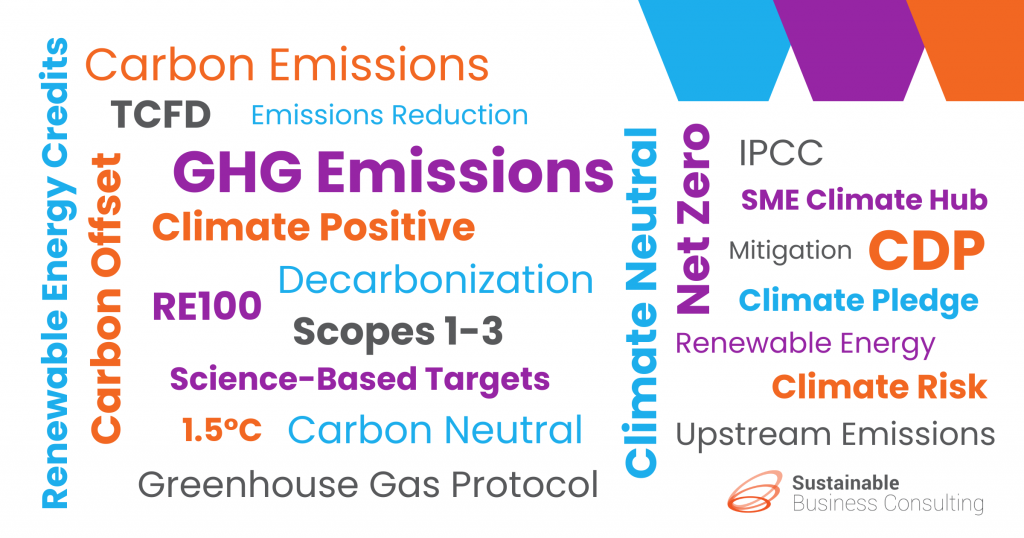A lot of technical language gets thrown around when policy makers, scientists, and other experts talk about climate change. For any business trying to navigate the climate action journey, decoding today’s climate jargon can feel overwhelming.
On top of this, it actually hinders progress. Tackling the climate crisis is already an immense, existential challenge. You shouldn’t have to overcome the additional barrier of learning a new language just to get started.
To help you cut through the noise, we’ve complied the climate action terms, commitments, and initiatives you need to know about, in plain language.
Climate Terms
Before we dive into the commitments and initiatives you might encounter on your climate action journey, there are a few climate terms you should be aware of. Give them a quick scan below:
Carbon Emissions: Climate change-causing emissions from carbon dioxide only (CO2).
Greenhouse Gas (GHG) Emissions: All emissions that contribute to climate change. The main greenhouse gases (GHGs) are carbon dioxide, methane, nitrous oxide, and fluorinated gases. These emissions are measured in units of “carbon equivalent” (CO2e) based on their potential to heat the planet. Today, most leading companies are focusing on GHG emissions rather than just CO2 emissions.
Scopes 1-3: A way to categorize GHG emissions. Scope 1 emissions come from sources you own or operate, such as buildings and vehicles, and Scope 2 emissions come from energy you purchase to operate, like electricity. Scope 3 emissions are the trickiest to address but often account for the majority of your impact. They come from activities you don’t directly own, such as the creation of goods in your supply chain.
Upstream Vs. Downstream Emissions: Another way to think about Scope 3 emissions. Your upstream emissions could include things like materials sourcing, transportation of goods to your business, and employee commuting. Your downstream emissions might include transportation of goods from your business, use of your products after they’re sold, and how your products are disposed of.
Climate Risk Analysis: A way to understand the impacts of climate change on your company’s future viability. These are broken out into physical risks (risks from changes in weather) and transition risks (risks from transitioning to low-carbon economy).
Climate risk is also often talked about alongside mitigation and adaptation. Mitigation means finding ways to reduce GHG emissions to prevent additional temperature rise. Adaptation means changing how we live to shield ourselves from the impacts of climate change we can’t avoid.
Renewable Energy: Energy produced from sources that naturally replenish and don’t run out. Common sources include sun, wind, hydroelectric, and geothermal.
Decarbonization: Reducing or eliminating GHG emissions from your energy sources. For instance, shifting to renewable energy sources to power your operations or phasing out traditional fleet vehicles in favor of electric ones.
Carbon Offset: A certificate representing the reduction of a certain amount of GHG emissions. Many companies buy these certificates to balance out their own emissions – purchases typically fund renewable energy, methane capture, and forest conservation projects.
Be careful not to use carbon offsets as a substitute for real climate action. Offsets should be the cherry on top to your GHG reduction initiatives, not the core strategy.
Renewable Energy Credits (RECs): RECs are simply an attribute you buy – one REC is created for every megawatt hour of renewable energy generated. RECs can offset emissions from your electricity use, in essence allowing you to claim that you’re using a certain percentage of renewable energy instead. There are two kinds of RECs, bundled and unbundled. Learn about the differences here.
As a rule of thumb, use unbundled REC’s sparingly. They typically don’t add any new renewable energy to the grid and therefore have less of a positive impact than bundled RECs.
1.5°C: The scientific consensus on the maximum amount of global temperature rise we can allow to avoid the worst effects of climate change, as compared to late 1800s levels. Right now, we are at 1.1°C of warming.
Intergovernmental Panel on Climate Change (IPCC): Provides policy makers with regular scientific assessments on climate change. For the world at large, it’s the most reputable source for the implications of climate change and how we should respond. Here are a few takeaways you should know from the latest series of reports:
- To limit temperature rise to 1.5°C, GHG emissions must halve by 2030 and peak by 2025.
- Every region on Earth will be affected by climate change, but those that have contributed least to the problem – Africa, Central America, and South Asia – will face the harshest consequences.
- Every fraction of a degree counts – each incremental increase in temperature will lead to dramatically more disease, death, and natural disasters.
Greenhouse Gas Protocol: The world’s most widely used standards for GHG accounting. They’ll help you measure, manage, and report GHG emissions from your operations and your supply chain.
Climate Commitments
Now that we’ve covered the key terms, let’s dive into some climate commitments. Or, the different ways a business might go about reducing its GHG emissions.
Carbon Neutral: Carbon dioxide (CO2) your business releases is balanced out by an offset and/or eliminated through various emissions reduction strategies. As we mentioned earlier, first focus on ways to reduce emissions, then use offsets to balance out what little you can’t.
Also be wary of promoting your brand as carbon neutral if you’re relying heavily on offsets. You may find yourself in hot water from not only consumers but also the law, which is starting to crack down on greenwashing.
Net Zero: An internationally agreed upon goal to cut GHG emissions to as close to zero as possible. As set out in the Paris Agreement, the world must reach net zero by 2050 to keep global warming below 1.5°C.
To support this ambition, many climate-friendly businesses have also committed to reaching net zero by 2050. And as we explain in the next section, certain initiatives track and even mandate net zero commitments. As a result, net zero is becoming the go-to strategy for climate action.
While there are some challenges with the term, just remember that a robust net zero commitment includes emissions from not only your direct operations but also your supply chain.
Climate Positive (Formerly Carbon Negative): Going beyond achieving net zero by removing additional emissions from the atmosphere. In other words, saving more GHG emissions than you are generating. Brands typically use carbon offsets or try and help other businesses reduce their own footprints to achieve this extra benefit.
Percent Emissions Reduction: Committing to reducing your annual GHG emissions by a certain percent as compared to your baseline year. There are two kinds of emissions reduction targets. Intensity-based targets measure emissions per unit of something. For example, reducing your GHG emissions per unit of product sold by 50% by 2030, as compared to your 2018 baseline. Absolute targets are more robust because they refer to your total emissions. For example, reducing your GHG emissions by 50% by 2030, as compared to your 2018 baseline.
Percent emissions reduction targets typically supplement net zero goals with short-term milestones.
100% Renewable Energy: Committing to sourcing 100% renewable energy for your operations by a certain year. Again, while this typically isn’t a standalone strategy, shifting to renewables is a critical part of the net zero journey.
100% Clean Energy: Similar to 100% renewable energy but includes a wider range of technology. In additional to wind and solar, clean energy can include things like nuclear, biofuels, and carbon capture.
Climate Initiatives
What's keeping businesses accountable on these commitments? Here are some tracked and certified initiatives that are driving ambitious climate action:
Climate Neutral: A non-profit certification that requires brands to measure, offset, and reduce the GHG emissions they generate. The Climate Neutral Certified label allows consumers to choose a climate-friendly future with their purchases. Over 350 companies have been certified so far.
Climate Pledge: A community of businesses committed to achieving net zero by 2040, ten years ahead of the Paris Agreement. Led by Amazon, signatories must also regularly measure and report GHG emissions and implement meaningful decarbonization strategies like energy efficiency improvements, materials reduction, and more. In other words, not just offsets.
Science-Based Targets Initiative (SBTi): Provides companies with a clearly defined path to reduce emissions through validation of GHG targets. Companies setting Science-Based Targets (SBTs) are held to the rigorous standards needed to limit temperature rise to 1.5°C. This means committing to net zero by 2050, halving emissions by 2030, and setting goals for all three scopes.
CDP: A system for helping companies measure and manage climate impact and benchmark performance against their peers, accomplished via an annual questionnaire. CDP is the gold standard for corporate environmental disclosure – over 13,000 companies disclosed through CDP in 2021.
Task Force on Climate-Related Financial Disclosures (TCFD): Created a set of Key Recommendations to improve reporting of climate risks and opportunities to banks and investors. In addition to meeting investor expectations, following these recommendations will help you identify what your climate risks are, how they’ll impact your business, and how you should mitigate them.
RE100: Global renewable energy initiative bringing together today’s biggest corporate electricity users committed to 100% renewable energy. Led by Climate Group and in partnership with CDP, this initiative is accelerating change towards zero carbon energy grids.
SME Climate Hub: Empowers small to medium sized businesses to take climate action. It does this by helping SMEs measure their GHG footprint and providing trainings, tools, and resources to improve. Participating companies must pledge to halve emissions by 2030, achieve net zero by 2050, and report on progress yearly.
----------------------
Phew, that’s a lot of climate jargon! If you ever need help navigating your climate action journey or want to learn more about these terms, our door is always open. Get in touch with us here.



